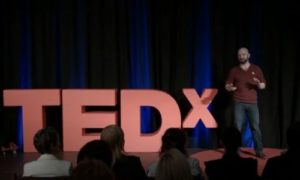Great coaches are original, non-interchangeable, and irreplaceable––these are all essential traits of the world’s best coaches. If you’re unoriginal, the market will always figure out how to deliver the same product, service, or outcome as you with less money. But if you’re original, you’re uncopyable—you stand out amongst the crowd.
The key to your originality as a coach is the public expression of your unique perspective, the view that the world needs to hear or experience.
But we don’t always know what this perspective is. And even if we do, we may struggle to understand how to bring it into reality.
While most of us admire those who create original things, many need help understanding how to get there ourselves. Therefore, most coaches don’t strive for originality because it’s scary, they fear copying people, or they’re too focused on getting quick results.
Originality is a long game.
So if you are ready to explore bringing more originality into your work, keep reading because I’ve broken the process into five clear phases.
Phase 1: The Hunch
Whenever you get an idea or see an opportunity for greater originality in your work, it typically starts with just a hunch. Now, you don’t have to have a clear idea of what to do with the hunch. It is often just the sense that something needs creating, a question needs answering, or an issue needs addressing. There may be an opportunity we’ve subconsciously noticed, even if we don’t know exactly what or where it is.
This hunch is the universe sending you a message, saying, hey, there might be something here that needs your investigation, care, or attention.
The hunch may be a conversation you’re repeatedly having with multiple clients or a new challenge that seems particularly interesting. Sometimes a hunch shows up as a potent sign, but most of the time, it’s just a whisper. It may or may not lead to a successful new idea or even mean anything long-term.
The hunches that do pan out will start to grow and formulate a greater sense of structure the more you think about them. The trick is to listen and look for hunches everywhere and in everything you do.
Phase 2: Imitation
Often the hunch will grow and become more tangible in phase 2, which is the imitation phase.
Anytime you’re trying to create something new, an excellent way to start is with a baseline structure, an outline of what it could look like.
Here is where the use of imitation is valuable. Now, most people skip over this stage and attempt to start from scratch instead. However, beginning with an imitation gives you the building blocks required to create something useful and functioning with less time and effort.
For example, if you’re building a website, the first thing to do is find examples of existing websites that you like. Find a model that’s already built out and use it as the base structure for your own. Avoid taking someone else’s work and tweaking it to fit your needs. Instead, strip the existing framework down to its bare bones and fill out the empty spaces with your own content and ideas.
Probably around 90% of what you create via imitation will not be “as good” as the original you based it on, but that’s okay––it’s not supposed to be. Think of it this way: if you’re digging a diamond out of a rock, you first pull the whole rock out and then chisel it down and refine it from there.
But how can you imitate if you’re creating something original? The hunch gives you the direction of inspiration; the imitation framework allows you to find gaps in your idea or expression. You use it as a guide, NOT a hack.
Phase 3: Experimentation
Once you have the basic framework, you can experiment and get even more creative. With a website, for example, you can change headings, fonts, text, the order of different sections, and so on. Because you have a framework of something that already works, the puzzle pieces are already on the table; it’s now up to you to move them around.
What’s helpful about this stage is that you’re simultaneously creating and learning as you go. You teach yourself how to do the thing while actively and iteratively experimenting, so you get more creative in your solutions throughout the process.
Most importantly, you learn what does and doesn’t work, which helps you fine-tune your current project or creation and save time on future ones.
Phase 4: Derivative
Once you’ve completed phase 3, you end up with a somewhat-finished product that is likely considered “derivative.” It’s a finely-honed version of something that looks like something else. It is a creation based on an existing but uniquely-refined framework.
It often doesn’t stand out, but it works, and it’s unique enough to you and your brand that it starts to feel like yours. This stage is a point of victory, a stage at which to celebrate.
Many creations that are technically derivative of others still look very nice and, most importantly, do their job. However, they are not supposed to be unique or stand out significantly. A website, for most coaches, is meant to act as a business card. So if your site looks like other good coaches’ websites, then great!
Stopping at the derivative stage is generally acceptable; 80-90% of people stop here for most projects. You don’t need to go any further for most pieces of content. Your work isn’t 100% creative, but not everything needs to be completely new; a tweak on an old idea will suffice. So if you want to keep going, there’s just one more step to originality.
Phase 5: True Original
This stage takes a lot of courage. You have to be willing to trust your vision, regardless of what others are doing or saying. It can also take time, and MANY tries, to create something unique.
The other important thing to remember is that we can’t start with originality––so it’s not worth trying to skip ahead to this stage. Most artists begin with imitation, using various role models as inspiration. They only develop their unique style after a lot of time, effort, and experimentation.
Establishing a 100% original style can be challenging–some would even say this is impossible. So often, we try to create something original, but no matter what we try, it still feels derivative of something else. That’s okay. We are a product of those who came before us and shaped our experiences and development as coaches, leaders, and people.
But when we do come up with something original, we often find it worse than the derivative things we came up with before. If you find this is the case, don’t be disheartened. You are giving up the safety and solidity of the derivative for something that is less stable and that, by nature, will sometimes be less good. To excel at creating something original takes time.
As you practice, you start to understand the process by which things work and the rules that govern them. Once you know the rules, you can experiment beyond them. You begin to see what’s there and not, and that’s when genuinely-original things typically arise.
But it’s important to remember that knowing and practicing the rules are very different. Knowing the rules doesn’t mean you can easily break or modify them. That only comes after you practice and understand the rules from experience.
Once you do this, something original will often emerge as you consider novel ways to address the demands of your creation.
You only have to be original where it matters.
If originality is something you’re struggling with, remember that you don’t need to be original everywhere. That would be far too strenuous and difficult to achieve, even by the most original and creative people. And I’m the first to admit it: I’m actually quite boring and derivative in many areas. But I’m original where it counts––with my clients and in my writing.
So the next time you set out to create something new, try this 5-step process, and do let me know how it goes! I’d love to hear from you.
Love,
Toku


